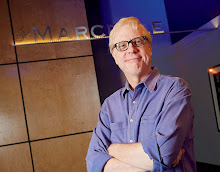 Last night, we had a read-thru-sing-thru of the whole show, though to be honest, there wasn't a lot of read-thru, mostly just sing-thru... There's maybe a dozen pages of dialogue in the whole show. I realized, listening to the whole show, that this is as close to a jazz opera as anything I've worked on before. What amazing, powerful material! I'm more baffled than ever by why this show didn't run longer off Broadway. It's so amazing, so well-written, so full of emotional depth. Maybe it was just too dark. I think too often the audience for musicals in New York doesn't really want to be challenged as much as they want to be comforted.
Last night, we had a read-thru-sing-thru of the whole show, though to be honest, there wasn't a lot of read-thru, mostly just sing-thru... There's maybe a dozen pages of dialogue in the whole show. I realized, listening to the whole show, that this is as close to a jazz opera as anything I've worked on before. What amazing, powerful material! I'm more baffled than ever by why this show didn't run longer off Broadway. It's so amazing, so well-written, so full of emotional depth. Maybe it was just too dark. I think too often the audience for musicals in New York doesn't really want to be challenged as much as they want to be comforted.We don't comfort much at New Line Theatre, so The Wild Party is perfect for us.
I'm so proud of this cast. This really is the toughest score we've worked on since Sweeney Todd. A few other shows have come close -- Passion, Sunday in the Park -- but they weren't quite this challenging. And though we've been moving fairly fast in learning the score, the cast really got it last night. Sure, there were rough patches here and there, but nothing major, nothing for me to worry about. And poor Margeau (Queenie) -- she has so much material to learn, but she did a really great job too.
There was a lot of excitement last night. Some of it came from the leads, who were all very nervous. Even though I do my best to remind everyone that this isn't a performance, just a sing-thru, still the leads feel some pressure -- it's the first time the cast has heard some of this material (especially since the whole score is not on the CD), and the leads want to be Great. But there's also excitement because everyone knows last night's rehearsal ends the first part of the process, and on Thursday we start staging the show. We're really on this train now and we won't get off of it until we close. It's been hard work up till now, but from here on out, it's going to be very hard work, as they work on memorizing this massive score, learning the blocking, learning the choreography, and now working in earnest on character.
 I've also been giving the actors handouts about what was going on in America (particularly New York), both in 1928 and also in the decade leading up to 1928. I found that many things that were happening in the culture are consciously referenced in the show. Some of the characters themselves reference real-life people. The D'Armano Brothers reference the Gershwin Brothers, but also the many gay musical comedy songwriters of the period, like Cole Porter and Larry Hart. Madelaine True mirrors the many famous, open lesbians of the period. Eddie represents the central place boxing had in pop culture at the time, with two world-famous boxing matches in 1926 and 1927 between Jack Dempsey and Gene Tunney. And of course, Burrs and Queenie's vaudeville was America's favorite mainstream entertainment, which reached its peak in 1928.
I've also been giving the actors handouts about what was going on in America (particularly New York), both in 1928 and also in the decade leading up to 1928. I found that many things that were happening in the culture are consciously referenced in the show. Some of the characters themselves reference real-life people. The D'Armano Brothers reference the Gershwin Brothers, but also the many gay musical comedy songwriters of the period, like Cole Porter and Larry Hart. Madelaine True mirrors the many famous, open lesbians of the period. Eddie represents the central place boxing had in pop culture at the time, with two world-famous boxing matches in 1926 and 1927 between Jack Dempsey and Gene Tunney. And of course, Burrs and Queenie's vaudeville was America's favorite mainstream entertainment, which reached its peak in 1928.This is one of those shows I feel very privileged to work on. And I think everybody else involved feels the same way. As hard as the road ahead of us may be, I have no doubt we will all rise to the challenge. These folks are working really hard. (The more I write about this show, the more I notice how often I'm using forms of the word challenge.)
Stay tuned...
Long Live the Musical!
Scott







0 comments:
Post a Comment